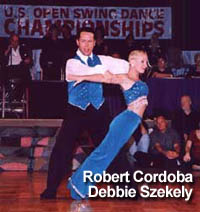 WEST COAST SWING: HISTORY kurt lichtmann
Development: When Jitterbug was banned from virtually every serious dance hall in the late '40s (too many injuries to self and others from kicks, jumps, etc.) "Sophisticated Swing" began to flourish. The real push behind its development cames in the '50s, in the studios of Arthur Murray! This man spent lavishly on Research & Development. He can be credited with the first codificatons of West Coast Swing, and its next name of Western Swing. The followers "walk forward" at the beginning of patterns was standardised in his studios. Where did this "walk forward" derive from? Swing-era leaders infatuated with the "Whip" move, with its follower "walk-walk" (instead of a rock-step) probably helped evolve an entire genre. And followers, if a leader pulls you forward while you are trying to rock back, guess which way you are going to end up going? Dean
Collins: A breathtaking dancer, brilliant choreographer,
and clever adapter of dance styles. Without him, where would West Coast
Swing be? He certainly popularized the "slotted Lindy" approach,
and an exploration of the smoother style. Did he create it? Did he see
it elsewhere and adapt it? Strangely, he denied any connection of himself
with West Coast Swing! His classic refusal to discuss swing history
was, "It's all swing!" Music: In the 1940s, the dominant musical style in Southern California seems to have been Country Swing aka Western Swing, the type of music played by Bob WIlls and The Texas Playboys. So it is no surprise that was the name adopted by the Arthur Murray studios for the dance Laura Haile observed. By the '50s Rhythm & Blues had become the standard WCS dance music. Additionally, plenty of WCS dancers still enjoy smooth swing to music that others might use for slow Fox Trot. 112 - 120 bpm for WCS is optimal. Yet, for some, things really heat up at the slower tempos: 90 -100 bpm. In the post-disco era, "groove dancers" thrive on funky non-swing 120-ish bpm disco. Disgusted beginners (and others?) retort, "This isn't swing!." Yet, many of the best WCS dancers today evolved from the disco era, and really dig disco grooves for WCS. And it is incredible to watch them: do they get turned on! Accomplished dancers also relish occasional faster grooves: 140 - 150 bpm. At this point, naive beginners accost the DJ that "this is not appropriated music for WCS." Funk: In reply to conservatives, the "funk & groove" WCS dancers are certainly closer to the spirit of original swing dance than one might think. Why? Original Lindy Hop is simply this: Partnered-Jazz Dance . Lots of full body exploratory rhythmic movements, waves, twists, etc. All organically created in a partnered context, fueled only by personal and inter-personal interpretations of the music. "Patterns," the European influence, are of minimal importance. "Partnering," also from the European side is of primary importance. Jazz movement, and the valuation of individuality (even outrageous individuality) is the African influence, and of equal primary importance. Hence the term "Partnered Jazz Dance." Influences: Latin styles (Salsa) and Hustle influenced WCS from the '70s on up. Beginners seeing Hustle and West Coast Swing often cannot distinguish them - not surprising, since Hustle dancers tend to Hustle-ize WCS. Check it out: is the lady getting space to play during, and at the end of of passes? Is play with the connection part of the dance? Is there breathing space and pauses, or just non-stop move after move? Do you see Jazz movement and complex footwork, or ballroom posturing and unchanging footwork? Events:
At one time California's US Open Swing was the national West
Coast Swing BIG EVENT. Seems like Atlanta's Grand Nationals is
becoming the big one now. In the East, we've also got some fun West
Coast Swing events: Boston Tea Party, and Summer Hummer.
Photo: Robert Cordoba & Debbie Szekey - WCS National Champs |
Want more on West Coast Swing? Well, let's GO WEST!
 West
Coast Swing is the state dance of California.
It's origins are definitely in Lindy Hop, but, "you've come a long
way, baby!" It's distinctive "dancing in a slot" approach derives
from San Diego dance halls as far back as 1938. The
kicking jitterbugs would frolic in the center of the floor, with the
smooth dancers grooving on the periphery. Many US Navy personnel seemed
to be exploring the smooth style, or were just too drunk to do anything
but watch the woman boogie back and forth. Please see
West
Coast Swing is the state dance of California.
It's origins are definitely in Lindy Hop, but, "you've come a long
way, baby!" It's distinctive "dancing in a slot" approach derives
from San Diego dance halls as far back as 1938. The
kicking jitterbugs would frolic in the center of the floor, with the
smooth dancers grooving on the periphery. Many US Navy personnel seemed
to be exploring the smooth style, or were just too drunk to do anything
but watch the woman boogie back and forth. Please see